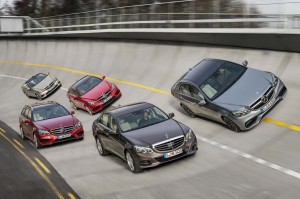
Soon the Mercedes E-Class will come with an updated driver-assistance system that makes the vehicle nearly autonomous.
Drivers of the next generation Mercedes-Benz E-Class due out next spring will be able to travel at speeds of more than 100 miles per hour, using the car’s automated driving features, according to technical papers released by Daimler AG, which emphasized the the new driver assistance features in the car will increase the comfort and relieve stress.
Based on an enhanced version of the Intelligent Drive system, which Mercedes-Benz has rolled out on the current E-Class and the new S-Class, the new system prepared for the 2017 E-Class will come with a Distance Pilot Distronic function. It automatically maintains the correct distance from vehicles in front of it by adjusting the car’s higher desired speed to that of a slower-moving vehicle ahead before accelerating back up to the desired speed once the way ahead is clear again – it can also follow traffic ahead in its lane at speeds from 0 to 120 mph, Mercedes-Benz said in the information it released to the press.
Despite active longitudinal and lateral guidance with significantly enhanced steering assistance, which gives the vehicle the ability to essentially drive itself in short spurts, the next level Intelligent Drive remains a semi-automated system in which the driver’s hands still need to be on the steering wheel.
Semi-automated driving on freeways and surface streets, autonomous braking in hazardous situations, and active assistance with evasive steering changes are just some of the functions of the new package coming on the E-Class. The goal is more comfort and less stress by reducing the pressure on the driver, combined with greater safety for all road users, according to Mercedes-Benz engineers.
Whether on highways or country roads, it is not only able to keep the car at a correct distance behind slower vehicles ahead automatically, but it can do so in a variety of conditions or speeds ranging from stop-and-go traffic to zipping along a freeway speeds … or higher.
By eliminating the need on the part of the driver to constantly accelerate and then brake, the tension level is lower. The system also provides steering assistance to the driver – even in curves. At speeds up to 80 mph, the system need not depend on clearly visible lane markings. The system can make driving easier, especially in traffic jams or heavy congestion.
The next generation E-Class will also come with an “Active Brake Assistance” system with enhanced functionality that can warn the driver of imminent crash situations and apply the brakes automatically in an emergency. In addition to detecting slower-moving, stopping or stationary vehicles, it also detects and reacts to crossing traffic at junctions, the tail ends of traffic jams and pedestrians in the danger zone ahead of the vehicle.
The new Evasive Steering System complements the pedestrian detection function of Active Brake Assist. When the driver deliberately or instinctively takes evasive action in a dangerous situation, the system can assist by adding precisely calculated steering torque to support the movement of the steering wheel, helping the driver to avoid the pedestrian in a controlled manner.
(Mercedes charges toward self-driving cars. For more, Click Here.)
Active Brake Assist uses radar sensors as well as a stereo-multi-purpose camera, which can detect whether the vehicle in front is slowing down, stopping or stationary. The Cross-Traffic Function of Active Brake Assist also detects cross-traffic and pedestrians in the danger area in front of the vehicle.
The intelligent assistance systems have been enhanced by updated algorithms and sensors such as for active lane keeping assist and active blind spot assist can warn of the risk of a lateral collision and intervene at the last moment to prevent an accident. the “Pre-Safe” function that can protect against collisions with traffic following behind.
The remote Parking Pilot of the E-Class makes it easier to move into and out of tight parking spaces or the garage. A remote-control system for moving into and out of narrow parking spaces and is controlled from outside the vehicle by smartphone via Bluetooth.
The “Car-to-X” technology in the new E-Class expands the scope of existing vehicle sensors, such as radar or camera systems for example. Information about potential hazards on the road can be forwarded to drivers at an early stage so that they can prepare for them and avoid critical situations altogether – such as those caused by suddenly changing weather conditions or stationary recovery vehicles at the side of the road.
(Click Here to find out more about the world’s first autonomous truck.)
As well as being able to receive hazard warnings, every vehicle equipped with Car-to-X technology can also send these warnings to other road users. As a result of the seamless integration of the Car-to-X system into the existing vehicle systems,
For Car-to-X Communication, Mercedes-Benz uses the vehicle’s integrated mobile-phone technology. In the Daimler Vehicle Backend server, the data are aggregated, checked for plausibility and forwarded to other similarly equipped vehicles in the relevant vicinity.
The system is configured to receive information from approaching rescue vehicles, such as police or fire-fighting vehicles, if the relevant data are provided by the respective operators in future. The dangerous situation in which drivers do not hear sirens could therefore become a thing of the past.
Preparations are likewise under way for integrating further sources of data.
(Jaguar Land Rover is developing an app to allow drivers to control their vehicles using a smart phone. Click Here for the story.)
Owners of the new E-Class will be able to use their smart phones as a vehicle key, opening up a wealth of individual possibilities. The smart phone merely has to be held near the door handle to unlock the vehicle, Mercedes-Benz said in its technical papers.


As good as the tech claims to be I am not a fan of semi-attentive driving. I think as more of the vehicles hit the roads, auto/truck makers are going to discover that without the driver being fully alert to everything happening around them, there will be more accidents when the system is unable to compensate for say an accident several cars in front of the electronically assisted vehicle.
The engineers get an “A” for effort but I believe they are going to find providing true autonomous vehicles that don’t crash or leave people stranded when the computers get confused, etc. as a very, very tall mountain to climb. Hell they can’t even fix the Windows O/S yet they think they can write proper code that will make an AV operate flawlessly? I’m from Missouri – the “SHOW ME” state, so show me the proof.
We recently saw what happens when fighter aircraft software was improperly installed… Four test pilot/engineers died. With all of these vehicles going to require weekly or more frequent software updates, what are the chances of a corrupted software update? The answer is: “quite high”.
I’m not saying we should not pursue AVs. I’m saying we should be damn cautious and not allow AVs on the roadways until they have proper redundant mission critical base systems, fail safe systems, proper emergency “limp modes” that won’t get the occupants killed or injured yet get the vehicle safely off the roadway, etc. this is a huge challenge before we even get to the ethical issues of who will die based on the computer programming, in an unavoidable crash.